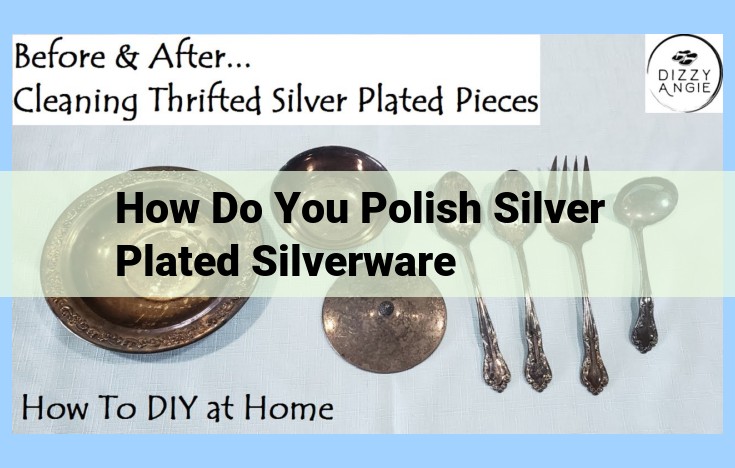How To Polish Silver Plate: A Step-By-Step Guide For Removing Tarnish

To polish silver plated silverware, start by gently removing tarnish with a soft cloth dampened with silver polish. Work in circular motions and rinse with warm water. If tarnish persists, combine baking soda and water to form a paste and apply with a soft toothbrush. Rinse thoroughly and dry with a clean cloth.
Silver Polishing and Restoration: A Guide to Preserve the Beauty of Your Precious Silver
In a world of ever-changing trends, the elegance and timeless appeal of silver remain unmatched. Whether it’s a cherished heirloom or a modern masterpiece, silver has an intrinsic charm that adds sophistication to any space. However, with time and exposure to the elements, the luster of silver can diminish, tarnishing its beauty and diminishing its value. This is where the art of silver polishing and restoration comes into play.
Polishing and restoring silver is not just a matter of aesthetics; it’s about preserving the integrity and value of your precious possessions. By removing tarnish and restoring the original shine, you not only enhance the visual appeal of your silver but also protect it from further damage. Whether you choose to tackle the task yourself or seek professional assistance, understanding the importance of silver polishing and restoration is crucial for maintaining the beauty and longevity of your silver treasures.
Cleaning Methods
Taking care of silver isn’t just a chore; it’s an art. And like any art form, there are many ways to approach it—each with its own unique set of tools and techniques.
Chemical Polishing
If you’re looking for a quick and easy way to spruce up your silver, look no further than chemical polishing. This method uses a chemical solution, often containing ammonia or sodium thiosulfate, to dissolve the tarnish from the surface of your silver. It’s a relatively safe and effective way to clean silver, but it’s essential to follow the instructions carefully and wear gloves to protect your skin.
Mechanical Polishing
For a more hands-on approach, you can use mechanical polishing to remove tarnish. This method uses abrasives such as polishing cloths or brushes to physically remove the tarnish from the surface of the silver. Polishing machines can also be used for larger items or for a more even finish. Mechanical polishing can be more time-consuming than chemical polishing, but it allows for more control over the process.
Electrochemical Polishing
Electrochemical polishing is a specialized technique that uses an electric current to remove tarnish from silver. This method is particularly effective for removing heavy tarnish, but it requires specialized equipment and should only be attempted by experienced users.
Materials for Silver Polishing and Restoration
Abrasives
When it comes to cleaning silver, soft abrasives are the key to removing tarnish without scratching the delicate surface. Soft brushes or toothbrushes dipped in water gently whisk away dirt and grime. For stubborn tarnish, baking soda can be sprinkled on a damp cloth and used as a gentle exfoliant.
Polishes
Silver polish is a specialized formula designed to restore the shine to tarnished silver. It typically contains mild abrasives, such as chalk or feldspar, as well as a chemical agent that reacts with the tarnish to remove it.
Other Alternatives
For those who prefer a more natural approach, aluminum foil and white vinegar can be used as effective DIY cleaning agents for silver. The aluminum reacts with the tarnish, while the vinegar helps neutralize the acids and prevent further tarnishing. To use this method, line a bowl with aluminum foil and pour in white vinegar. Submerge the silver item and let it soak for a few minutes before rinsing with water.
Professionals for Silver Polishing and Restoration
When it comes to expert silver restoration, silversmiths play a crucial role. They possess the necessary skills and knowledge to restore your cherished silver objects to their former glory. Silversmiths can repair broken items, replate worn-out coatings, and bring back the shine to dull and tarnished pieces.
Jewelers, on the other hand, specialize in cleaning and restoring silver jewelry. They possess the precision and expertise to handle delicate pieces with care. Jewelers can remove dirt, oxidization, and scratches from silver jewelry, restoring its original luster and beauty.
By entrusting your valuable silver objects to skilled professionals, you can ensure that they receive the highest quality care and are returned to you in impeccable condition. Silversmiths and jewelers have the necessary equipment, materials, and expertise to restore your silver to its optimal appearance.
Safety Precautions in Silver Polishing and Restoration
When dealing with silver polishing and restoration, it’s crucial to prioritize safety to safeguard your health and the environment. Here are essential precautions to observe:
1. Gloves: Essential Hand Protection
Protect your hands from harsh chemicals and abrasive materials by wearing gloves. Silver cleaning often involves strong cleaners that can irritate skin, while abrasives like baking soda or brushes can cause abrasions. Gloves provide a protective barrier against these elements.
2. Ventilation: Inhale Wisely
Ensure proper ventilation while working with chemicals used in silver polishing. Many of these chemicals release harmful fumes that can be dangerous to inhale. Open windows or use an exhaust fan to create proper air circulation and avoid respiratory irritation.
3. Eye Protection: A Clear View of Safety
Wear safety glasses to protect your eyes from debris and chemical splashes. Silver polishing can generate small particles that can fly into your eyes, causing irritation or even damage. Safety glasses serve as a shield to ensure your eyesight remains protected.
4. Chemical Disposal: Environmental Responsibility
Dispose of chemicals used in silver polishing properly. These chemicals can be harmful to the environment if not disposed of responsibly. Follow the instructions on the chemical’s packaging or consult with a local waste disposal facility for guidance on safe disposal practices to protect our planet.